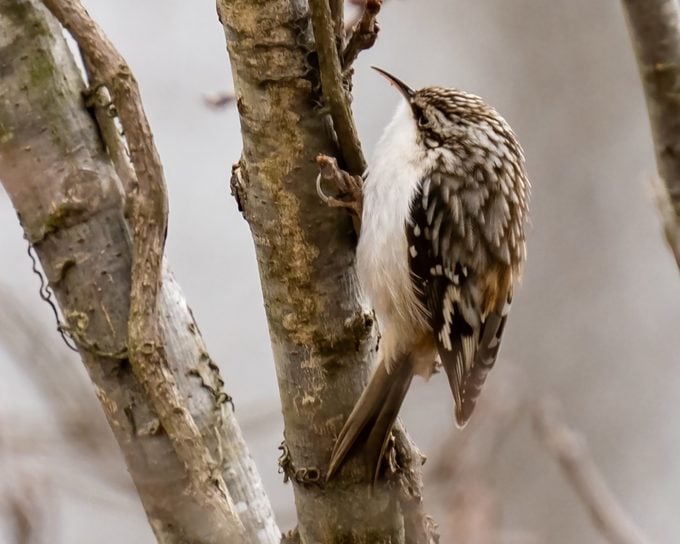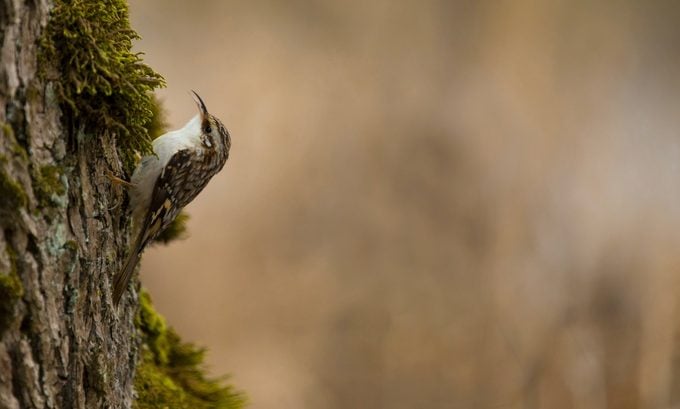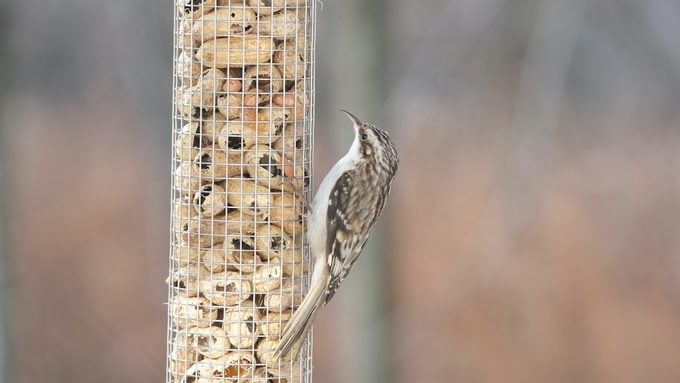How to Identify and Attract a Brown Creeper
Updated: Jul. 10, 2024
A brown creeper is a camouflage expert—it moves up tree trunks hunting for insects. Learn how to identify these tough-to-spot backyard birds.
On This Page
Brown Creeper Identification

Other songbirds may have flashier feathers, but the brown creeper’s stealthy movement and subtle markings make spotting one a thrill. Thanks to their wide range across much of the U.S. during the nonbreeding season, you’ve probably had a brown creeper visit your yard without even knowing it.
“Brown creepers can be so easily missed when you’re not looking, but they’re always fun to watch when you find them,” says Birds & Blooms reader Brent Angelo.

These unique birds get their funny name from the way they stick close to tree trunks as they hunt for insects, spiders and larvae. They use their long tails to steady themselves and their curved beaks to probe for food. Unlike nuthatches, brown creepers only climb up tree trunks, not down.
Brown creepers are tiny birds, just over 5 inches from bill tip to tail tip. Their size and their markings (streaks of brown and light brownish yellow) help them camouflage against tree bark, providing protection against predators. When startled, they freeze to blend in.
The key to identifying the birds is to observe their movement, says Emma Greig, who leads Project FeederWatch of the Cornell Lab of Ornithology. “They scuttle along trees and look a lot like mice,” she says. “They’re hard to see but sometimes you catch a glimpse of a little movement along a tree trunk. There aren’t any other species that look and behave like them.”
Spotted a mysterious bird in your yard? It might be one of these small brown birds.
Treecreeper Bird Family
The treecreeper family consists of 11 species, but the brown creeper is the only one found in most of North America. The treecreeper family consists of 11 species, but the brown creeper is the only one found in North America. Across the Atlantic you’ll find both the Eurasian treecreeper and short-toed treecreeper in parts of Europe, and the bar-tailed treecreeper in and around the Himalayas.
Diet: What Does a Brown Creeper Eat?

“I was thrilled to have this brown creeper (above) visiting my bird feeders last winter,” says Birds & Blooms reader Kerrie Wilcox.
Winter is an especially great time to attract brown creepers to your yard since insects aren’t as plentiful. Try serving energy-dense foods such as suet, or peanut butter smeared on a tree trunk. Brown creepers can also be tempted with hulled sunflower seeds. Emma also suggests making your yard insect-friendly. “Don’t use pesticides. Let a patch of lawn grow and go ‘feral,’ ” she says. “The more insects that are around, the more likely you are to have a brown creeper in your yard.”
Nesting Habits
A tree trunk serves as more than just a place for brown creepers to catch a meal. It’s also where they build their cuplike nests, tucked behind peeling bark. Dead or dying trees are the top choice of brown creepers. The birds occasionally construct nests in human-built structures, such as rain gutters and window shutters.
The male and female select a nest site together, but the female is the primary builder while the male finds materials. The nest holds five to six eggs and is built out of moss, leaves, hair, wood fibers, spider egg cases and more.
Learn how to identify and attract a tufted titmouse.
What Does a Brown Creeper Song Sound Like?
Bird sounds courtesy of the Cornell Lab of Ornithology
Until you memorize its sound, you’ll probably see a brown creeper before you hear it. That’s because their song is so high-pitched that it can be easy for a human to miss. Keep an ear out for the male’s short, thin song: trees, beautiful trees.
Next, learn how to tell the difference between a downy vs hairy woodpecker.
About the Expert
Emma Greig is the project leader of Project FeederWatch, a citizen science program, for the Cornell Lab of Ornithology. Emma holds a Ph. D. from the University of Chicago and previously was a postdoctoral associate in Macaulay Library.






















